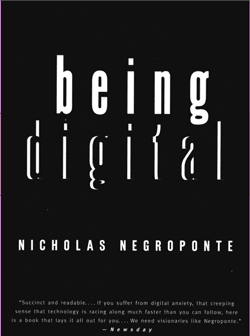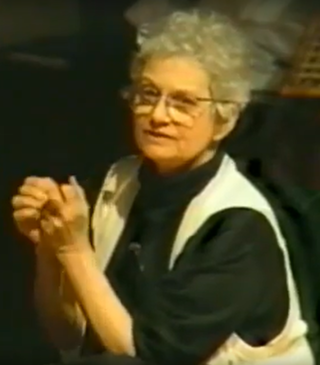
Nicholas Negroponte is a Greek American architect. He is the founder and chairman Emeritus of Massachusetts Institute of Technology's Media Lab, and also founded the One Laptop per Child Association (OLPC). Negroponte is the author of the 1995 bestseller Being Digital translated into more than forty languages.
The Aspen Movie Map was a hypermedia system developed at MIT that enabled the user to take a virtual tour through the city of Aspen, Colorado. It was developed by a team working with Andrew Lippman in 1978 with funding from ARPA.

The MIT Media Lab is a research laboratory at the Massachusetts Institute of Technology, growing out of MIT's Architecture Machine Group in the School of Architecture. Its research does not restrict to fixed academic disciplines, but draws from technology, media, science, art, and design. As of 2014, Media lab's research groups include neurobiology, biologically inspired fabrication, socially engaging robots, emotive computing, bionics, and hyperinstruments.

Scott Fisher is the Professor and Founding Chair of the Interactive Media Division in the USC School of Cinematic Arts at the University of Southern California, and Director of the Mobile and Environmental Media Lab there. He is an artist and technologist who has worked extensively on virtual reality, including pioneering work at NASA, Atari Research Labs, MIT's Architecture Machine Group and Keio University.

Ambient intelligence (AmI) is a term used in computing to refer to electronic environments that are sensitive and responsive to the presence of people. The term is generally applied to consumer electronics, telecommunications, and computing.
Smart environments link computers and other smart devices to everyday settings and tasks. Smart environments include smart homes, smart cities and smart manufacturing.

Being Digital is a non-fiction book about digital technologies and their possible future by technology author, Nicholas Negroponte. It was originally published in January 1995 by Alfred A. Knopf.

Muriel Cooper was a pioneering book designer, digital designer, researcher, and educator. She was the first design director of the MIT Press, instilling a Bauhaus-influenced design style into its many publications. She moved on to become founder of MIT's Visible Language Workshop, and later became a co-founder of the MIT Media Lab. In 2007, a New York Times article called her "the design heroine you've probably never heard of".

Andrew Gordon Speedie Pask was a British cybernetician, inventor and polymath who made during his lifetime multiple contributions to cybernetics, educational psychology, educational technology, epistemology, chemical computing, architecture, and the performing arts. During his life he gained three doctorate degrees. He was an avid writer, with more than two hundred and fifty publications which included a variety of journal articles, books, periodicals, patents, and technical reports. He also worked as an academic and researcher for a variety of educational settings, research institutes, and private stakeholders including but not limited to the University of Illinois, Concordia University, the Open University, Brunel University and the Architectural Association School of Architecture. He is known for the development of conversation theory.
Intelligent Environments (IE) are spaces with embedded systems and information and communication technologies creating interactive spaces that bring computation into the physical world and enhance occupants experiences. "Intelligent environments are spaces in which computation is seamlessly used to enhance ordinary activity. One of the driving forces behind the emerging interest in highly interactive environments is to make computers not only genuine user-friendly but also essentially invisible to the user".
Responsive architecture is an evolving field of architectural practice and research. Responsive architectures are those that measure actual environmental conditions to enable buildings to adapt their form, shape, color or character responsively.
The Internet of things (IoT) describes devices with sensors, processing ability, software and other technologies that connect and exchange data with other devices and systems over the Internet or other communications networks. The Internet of things encompasses electronics, communication, and computer science engineering. "Internet of things" has been considered a misnomer because devices do not need to be connected to the public internet; they only need to be connected to a network and be individually addressable.

A smart city is a technologically modern urban area that uses different types of electronic methods and sensors to collect specific data. Information gained from that data is used to manage assets, resources and services efficiently; in return, that data is used to improve operations across the city. This includes data collected from citizens, devices, buildings and assets that is processed and analyzed to monitor and manage traffic and transportation systems, power plants, utilities, urban forestry, water supply networks, waste, criminal investigations, information systems, schools, libraries, hospitals, and other community services. Smart cities are defined as smart both in the ways in which their governments harness technology as well as in how they monitor, analyze, plan, and govern the city. In smart cities, the sharing of data is not limited to the city itself but also includes businesses, citizens and other third parties that can benefit from various uses of that data. Sharing data from different systems and sectors creates opportunities for increased understanding and economic benefits.

The MIT School of Architecture and Planning is one of the five schools of the Massachusetts Institute of Technology in Cambridge, Massachusetts. Founded in 1865 by William Robert Ware, the school offered the first architecture curriculum in the United States and was the first architecture program established within a university. MIT's Department of Architecture has consistently ranked among the top architecture/built environment schools in the world.
Cyber–Physical System (CPS) are integrations of computation with physical processes. In cyber–physical systems, physical and software components are deeply intertwined, able to operate on different spatial and temporal scales, exhibit multiple and distinct behavioral modalities, and interact with each other in ways that change with context. CPS involves transdisciplinary approaches, merging theory of cybernetics, mechatronics, design and process science. The process control is often referred to as embedded systems. In embedded systems, the emphasis tends to be more on the computational elements, and less on an intense link between the computational and physical elements. CPS is also similar to the Internet of Things (IoT), sharing the same basic architecture; nevertheless, CPS presents a higher combination and coordination between physical and computational elements.
Pete Silver & Will McLean are two British architectural practitioners, educators, writers, and technical theorists who work together as a duo. They have taught at the Architectural Association, The Bartlett, and The University of Westminster's School of Architecture and the Built environment, thus gaining a privileged position in the contemporary London architectural scene.
Open-source architecture is an emerging paradigm that advocates new procedures in imagination and formation of virtual and real spaces within a universal infrastructure. Drawing from references as diverse as open-source culture, modular design, avant-garde architectural, science fiction, language theory, and neuro-surgery, it adopts an inclusive approach as per spatial design towards a collaborative use of design and design tools by professionals and ordinary citizen users. The umbrella term citizen-centered design harnesses the notion of open-source architecture, which in itself involves the non-building architecture of computer networks, and goes beyond it to the movement that encompass the building design professions, as a whole.

Molly Wright Steenson is an American professor of design and a historian of architecture and technology. Currently, Molly is the president and CEO of the American Swedish Institute. Previously, she was the Carnegie Mellon University Vice Provost for Faculty, K&L Gates Associate Professor of Ethics and Computational Technologies, and Senior Associate Dean for Research in the College of Fine Arts at Carnegie Mellon University.
The Internet of Military Things (IoMT) is a class of Internet of things for combat operations and warfare. It is a complex network of interconnected entities, or "things", in the military domain that continually communicate with each other to coordinate, learn, and interact with the physical environment to accomplish a broad range of activities in a more efficient and informed manner. The concept of IoMT is largely driven by the idea that future military battles will be dominated by machine intelligence and cyber warfare and will likely take place in urban environments. By creating a miniature ecosystem of smart technology capable of distilling sensory information and autonomously governing multiple tasks at once, the IoMT is conceptually designed to offload much of the physical and mental burden that warfighters encounter in a combat setting.

Usman Haque is an architect and artist who works with technology. He is known for designing large scale interactive installations and his contributions to Interactive architecture and the Internet of things.










